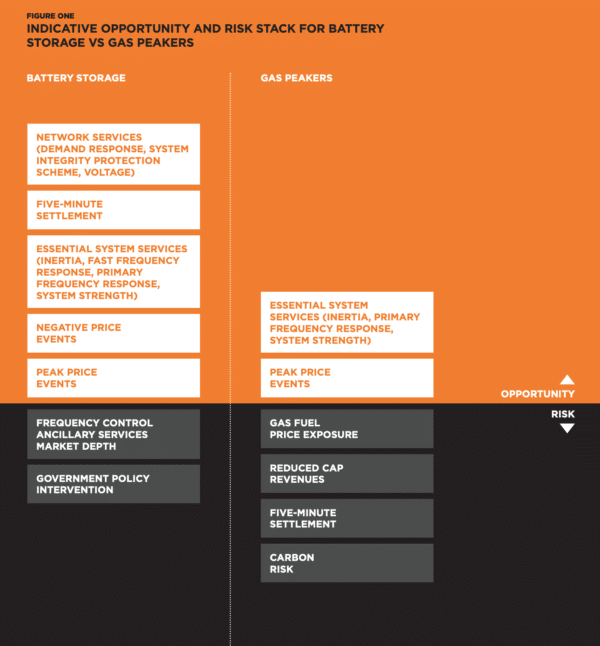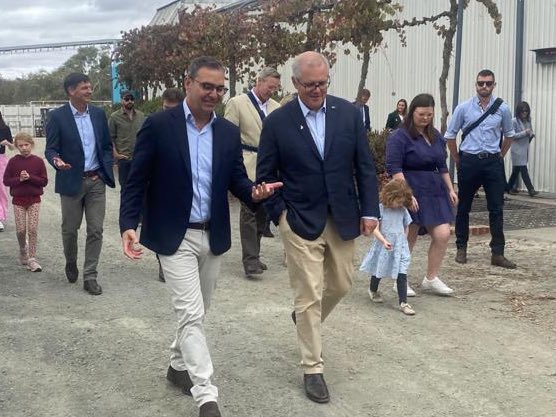In a $1 billion-plus so-called State Energy and Emissions Reduction Deal between the Commonwealth Government (contributing $660 million) and the South Australian Government (contributing $422 million), announced on the weekend, Prime Minister Scott Morrison and Energy Minister Angus Taylor blew a very loud trumpet for gas extraction, “to help increase the supply of reliable and affordable gas to users in South Australia and the broader east coast market”. But a number of urgently needed, renewable-energy-boosting projects also got a leg up.
The parties to the deal agreed on $100 million of joint support for Project EnergyConnect, a superhighway of new electricity transmission infrastructure connecting South Australia and New South Wales, with a diversion into Victoria, which promises to unlock gigawatts of planned renewable energy projects in its path, and help stabilise the tail end of the National Electricity Market, facilitating bi-directional energy flows as needed.
The funding will be allocated to “underwriting of key early works” for the 900 km, $1.53 billion project, which has been jumping through regulatory-approval hoops since 2018, and which is expected to commence construction this year, subject to completion of environmental planning and assessment process, resolution of land access discussions, and route refinement.
The eventual upshot for residential consumers is an expected $100 per annum reduction in electricity costs in South Australia, and between $58 and $64 less to pay in NSW; businesses will also benefit, and the project is expected to generate 1,700 jobs during construction, plus 950 ongoing positions.
Meeting and beating the Paris Agreement
The most substantial piece of the funding pie — $400 million from the Commonwealth — is allocated to investment in Federal Government “priority areas such as carbon capture and storage”, “electric vehicles”, neutral-coloured (unspecified) “hydrogen” and “other emissions reduction projects in South Australia to help meet and beat Australia’s commitments under the Paris Agreement”.
South Australian Premier Steven Marshall gave slightly more detail in his statement, saying that the agreement, “coordinates our efforts to deliver … the infrastructure needed for electric cars, and generate new revenue for farmers from carbon reductions”.
The Commonwealth is also proffering up to $110 million in concessional finance for solar thermal and “other storage projects in South Australia”, Morrison’s press release said.
The boy stood on the burning deck …
But the most detailed and primary of the key components of the deal is that South Australia agrees to generate an additional 50 petajoules per annum of gas by the end of 2023, and chase a stretch target of 80 petajoules per annum by 2030 “to help increase the supply of reliable and affordable gas to users in South Australia and the broader east coast gas market” — a general statement to which Angus Taylor added, “as part of our gas-fired recovery”.
It seems incredible in the wake of this month’s ABC Four Corners expose — Fired Up: What’s driving the Federal Government’s push for a gas-fired future — of the partisan machinations that contributed to this line of thinking, that the Government could still be brazenly pursuing it.
Tim Buckley, Director of Energy Finance Studies at the Institute for Energy Economics and Financial Analysis (IEEFA) in Australia and South Asia, commented last week that, “Conventional or ‘natural’ gas use in Australia’s National Electricity Market has fallen 59% in the last five years due to massive overpricing and supply concerns, while renewable energy has grown strongly.”
Batteries nudge out gas peakers
Almost at the same time as the Four Corners’ report, the Clean Energy Council released its study, Battery Storage: The new, clean peaker which showed that batteries are now able to more cheaply and efficiently meet peaks in electricity demand in the NEM than open-cycle gas turbine plants, or gas peakers, can. And they generate far fewer emissions.

Image: Clean Energy Council
As if in concert, in March, Australian gentailer AGL announced it would build one of the world’s biggest batteries (250 MW/1,000MWh) at its Torrens Island gas power plant in South Australia.
“The significance of this project is the four hours of storage, suggesting that AGL now sees batteries as already competitive with gas generators to meet peak demand periods,” says Buckley.
Gas prices too hot to handle?
Morrison’s announcement of the State Energy and Emissions Reduction Deal elaborates on its gas focus as, “Achieving improved and lower cost gas production in the Cooper Basin and a step change in gas production in the Otway Basin”.
Beach Energy has recently made new gas discoveries in the Otway Basin: first gas from two new wells in the Geographe field are expected in 2022, and its rig is then expected to move on to drill four more wells in the Thylacine discovery.
But only last Friday, Origin Energy gave an update on its share price guidance for FY2021 to investors, announcing “an adverse and unexpected outcome on a domestic gas contract price review” for gas purchased from Beach Energy’s Otway Basin fields, which had been referred to arbitration.
The arbitrator issued a partial award which will result in the gas price likely being above Origin’s expectations “and recent comparable wholesale contracts”, the company said.
Its update continued: “The outcome is expected to result in an increase in Origin’s cost of supply of $30-$40 million for FY2021, increasing further to $60-$80 million in FY2022 consistent with an expected increase in volume.”
This is just one example of the cost of gas belying the promise constantly made by Morrison and Taylor in relation to gas that it will provide “affordable, reliable power” and that “That is what reduces prices and creates jobs,” as Morrison said again on Sunday.
An agreed, minimal role for gas
Another recent report, Go for net zero: A practical plan for reliable, affordable, low-emissions electricity, released by Australia’s The Grattan Institute — a non-partisan think tank dedicated to informing public policy in key economic and social areas — this month confirmed that Australia “can achieve a net-zero carbon emissions electricity system without threatening affordability or reliability of supply”.
Authors of the report, Tony Woods, Director of Grattan’s Energy Program, and Associate, James Ha, summarise, “Gas is likely to play the critical backup role” to ramped up renewable supply, “though not an expanded role”.
That is, “Australia will make a gas-supported transition to a net-zero emissions electricity system – but not a ‘gas-led recovery’ from the COVID recession.”
Overall, yesterday’s SEERD but undercooked announcement by the Prime Minister showed a dogged adherence to gas-fired energy, some-kind-of-hydrogen, unproven carbon-capture-and-storage rhetoric that must make Australians nervous; given growing evidence in favour of other technologies providing cheaper, more reliable solutions that create far lower emissions in the first place.
The greater silk purse within the deal will likely emerge in specific projects over coming months. In the meantime, Premier Marshall, having signed up for gas, as NSW Premier Gladys Berejiklian did before him, reminded South Australians: “Importantly, this MoU backs the SA-NSW Interconnector” aka Project EnergyConnect, “which will secure the South Australian grid, increase renewable energy and bring down bills for consumers in SA by around $100.”
This content is protected by copyright and may not be reused. If you want to cooperate with us and would like to reuse some of our content, please contact: editors@pv-magazine.com.









1 comment
By submitting this form you agree to pv magazine using your data for the purposes of publishing your comment.
Your personal data will only be disclosed or otherwise transmitted to third parties for the purposes of spam filtering or if this is necessary for technical maintenance of the website. Any other transfer to third parties will not take place unless this is justified on the basis of applicable data protection regulations or if pv magazine is legally obliged to do so.
You may revoke this consent at any time with effect for the future, in which case your personal data will be deleted immediately. Otherwise, your data will be deleted if pv magazine has processed your request or the purpose of data storage is fulfilled.
Further information on data privacy can be found in our Data Protection Policy.